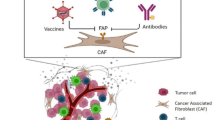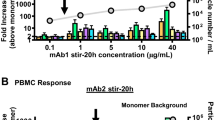Summary
Serum factors may be responsible for reduced host-anti-tumor defence. Although there is still confusion about their origin, attempts have been made to immobilize serum components by Protein A columns as a therapeutic modality. In our study the in vitro adsorption of 90% of the IgG from cancer sera on “immobilized protein A” did not influence the inhibitory serum activity as measured in a mixed lymphocyte culture. Therefore, IgG or immune complexes do not seem to be the suppressive serum factor in patients with advanced colorectal carcinoma. There is evidence for leakage of small amounts of protein A from the columns which have immunostimulatory activity. Perhaps this may explain necrosis after a therapeutic immunoadsorption.
Similar content being viewed by others
Abbreviations
- CEA:
-
Carcinoembryonal antigen
- C Effluent:
-
Unadsorbed fraction
- C Eluate:
-
Adsorbed fraction
- CP:
-
Cancer plasma
- CPG:
-
Controlled pore glass beads
- CPM:
-
Counts per minute
- C Sera:
-
Sera from patients with metastatic colorectal cancer
- HSA:
-
Human serum albumin
- 3H-Tdr:
-
3H-thymidine
- MLC:
-
Mixed lymphocyte culture
- NP:
-
Control plasma
- N Sera:
-
Sera from healthy persons
- PBMNC:
-
Peripheral blood mononuclear cells
- PBS:
-
Phosphate-buffered saline
- PI:
-
Untreated plasma probes
- RPMI 1640:
-
Culture medium (Ross Park Memorial Institute)
- SAC:
-
Staphylococcus aureus Cowan I
- SAW:
-
Staphylococcus aureus Wood
- SpA:
-
Purified staphylococcal protein A
References
Bansal SC, Bansal BR, Thomas HL, Siegel PD, Rhoads JE, Cooper DR, Terman DS, Mark R (1978) Ex vivo removal of serum IgG in an patient with colon cancer. Cancer 41:1–18
Bolander FF, Fellows RE (1975) Growth hormone covalently bound to Sepharose or glass. Analysis of ligand release rates and characterization of soluble radiolabeled products. Biochemistry 14:2938–2943
Catalona WJ, Ratliff TL, McCool RE (1981) Gamma-interferon induced byS. aureus protein A augments natural killing and ADCC. Nature 291:77–79
Davidson MB, van Herle AJ, Gerschenson LE (1973) Insulin and Sepharose-insulin effects on tyrosine transaminase level in cultured rat liver cells. Endocrinology 92:1442–1446
Hakansson L, Eneström S, Jonsson S, Lieden G, Lindgren S, Söderberg M (1984) Treatment of tumor patients by ex vivo affinity chromatography of blood plasma over immunoglobulin-binding protein-A-Sepharose. Eur J Clin Invest 13:A39
Kamo I, Friedman H (1977) Immunosuppression and the role of suppressive factors in cancer. Adv Cancer Res 25:271–321
Petrini B, Mööby R (1981) Activation of human lymphocytes in vitro by membrane-damaging toxins fromStaphylococcus aureus. Infect Immunity 31:134–148
Ray PK, Bandhopadhyay S (1982) Plasma elution of biomolecules from non-viableStaphylococcus aureus Cowan I. Fed Proc 41:556
Ray PK, Idiculla A, Mark R, Rhoads JE, Thomas H, Bassett IG, Cooper DR (1982) Extracorporal immunoadsorption of plasma from a metastatic colon carcinoma patient by Protein A-containing nonviableStaphylococcus aureus. Cancer 49:1800–1809
Römer W, Rauterberg EW (1980) Repeated affinity chromatography on glass beads with stable capacity: one-step purification of polyclonal IgA or IgM. J Immunol Methods 38:239–250
Sakane T, Green I (1978) Protein A fromStaphylococcus aureus — a mitogen for human T lymphocytes and B lymphocytes but not L lymphocytes. J Immunol 120:302–311
Schuff-Werner P, Beyer JH, Nagel GA (1982) Serum-blocking factors in tumor-bearing hosts: the value of extended plasma exchange on in vitro immune parameters of patients with advanced cancer. Adv Exp Med Biol 155:369–378
Steele G, Ankerst J, Sjögren HO (1974) Alteration of in vitro antitumor activity of tumor bearer sera by adsorption withStaphylococcus aureus Cowan I. Int J Cancer 14:83–92
Tesser G, Fisch HU, Schwyzer R (1974) Limitations of affinity chromatography: solvolytic detachment of ligands from polymeric supports. Helv Chim Acta 57:1718–1730
Weetall HH (1976) Covalent coupling methods for inorganic support materials. In: Mosbach K (ed) Methods in enzymology. Academic Press, New York, vol XLIV, pp 134–148
Wilchek M, Oka T, Topper YJ (1975) Structure of a soluble superactive insulin is revealed by the nature of the complex between CNBr-activated Sepharose and amines. Proc Natl Acad Sci USA 72:1055–1058
Author information
Authors and Affiliations
Additional information
Supported by the BMFT, project no. 03/8410/0
Rights and permissions
About this article
Cite this article
Richner, J., Schuff-Werner, P., Bätge, R. et al. In vitro adsorption of colon cancer sera over staphylococcus protein a: lymphocyte stimulation by leakage of adsorbance. Klin Wochenschr 65, 353–358 (1987). https://doi.org/10.1007/BF01745571
Received:
Revised:
Accepted:
Issue Date:
DOI: https://doi.org/10.1007/BF01745571




